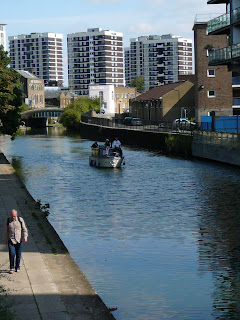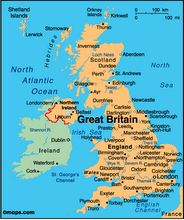
On Wednesday, I had booked myself in to a day trip with Allen's Tours that followed the Antrim Coast road up around the northern coastline of Northern Ireland. I got up early and had a solid cooked breakfast at the B&B before making the long walk into the city centre to hop on the Allen's Tours coach.
The day started fairly grey and drizzly, but gradually cleared throughout the morning and it was warm and sunny by the early afternoon. After leaving Belfast, the first stop was at the Carrickfergus Castle. We did not go inside the castle, as there was a lot of ground to cover during the day. Carrickfergus Castle was built by John de Courcy in 1177 after he conquered eastern Ulster. This is the spot where King William III (William of Orange) first set foot in Ireland in 1690, after General Schomberg attacked and took the castle the same year. There is a statue outside the castle of William of Orange. On the outskirts of the town of Carrickfergus, we passed the spot where the parents of America's 7th president, Andrew Jackson, lived just before they emigrated in 1765 to the United States, where Jackson was born in 1767.
Back on the bus, we headed further up County Antrim, through the small town of Glenarm and on to our second stop of the day, the small picturesque harbour town of Carnlough. There is an old hotel on the main street through Carnlough called the Londonderry Arms, which was once owned by Sir Winston Churchill, who occasionally stayed in the hotel and went fishing in the nearby harbour. We had about 15 minutes to stretch the legs in Carnlough and I went into a little corner dairy to buy a chocolate bar. The guy working in the dairy was your typical friendly Irishman who was fascinated that a Kiwi had found his way to a small town on the coast of Northern Ireland and he chatted away for a solid five minutes. He would still be chatting to me now if I hadn't insisted on leaving to catch the bus!
From there we drove through the green Glens of Antrim. The Glens of Antrim is a region comprising nine glens or valleys formed by melting glaciers centuries ago. The glens are an "area of outstanding natural beauty" and are a major tourist attraction in Northern Ireland. We drove through six of the nine glens on our way to the Carrick-A-Rede rope bridge.
The Carrick-A-Rede rope bridge is a rope suspension bridge near the town of Ballintoy. It links the mainland with the tiny Carrick Island. It spans 2o metres and is 30 metres above the rocks below. It is thought salmon fishermen have been erecting rope bridges to the island for over 350 years. The bridge is now mainly a tourist attraction, and there were 227,000 visitors in 2007. The coastal scenery around the rope bridge is breath-taking. The photos below probably do not do justice to the beautiful green hills, the jagged rocky cliffs, the waves crashing on to the shore far below and the small islands just off the coast. It really is stunning. We could just see Rathlin Island out to sea, but it was a little hazy in the distance. Beyond Rathlin Island and further to the east is the Mull of Kintyre, which apparently you can see on a clear day, but we could not see it.
We had lunch from the tearooms at Carrick-A-Rede, which was actually very nice. I had a roast chicken sandwich and a piece of chocolate fudge. Then we were on the road again, this time just for a short distance before we stopped in at the nearby town of Ballintoy to check out its historic pub, the Fullerton Arms. I also wandered down to the edge of the town to check out the small white church sitting in the middle of some farmland. Apparently the church is the most photographed church in Ireland...I found that difficult to believe!
The next stop was the Old Bushmills Whiskey Distillery. The Old Bushmills Distillery was founded in 1608, making it the oldest licensed whiskey distillery in Ireland, although historical references to distilling at Bushmills can be traced back to around 1490. Again, we did not have time to do a tour of the distillery, but we stopped in at the gift shop and I bought a sample pack of their three most popular whiskeys as well as some whiskey-flavoured chocolate and fudge.
A little further up the road from Bushmills lie the ruins of Dunluce Castle, the most extensive ruins of a medieval castle in Northern Island. Richard de Burgh, Earl of Ulster, first built the castle in the 1200s.
Then it was on to our final stop of the day and the highlight of the tour, the Giant's Causeway. The Giant's Causeway is a collection of around 40,000 interlocking basalt columns, the result of an ancient volcanic eruption. The tops of the columns form stepping stones that lead from the foot of the cliff and disappear into the sea. Most of the columns are hexagonal but some have four, five, seven or eight sides. It is thought that the columns are around 62-65 million years old. The Giant's Causeway is a UNESCO World Natural Heritage site and is one of the greatest natural wonders in the United Kingdom.
The legend of the Giant's Causeway is that Irish giant Finn McCool built the causeway between Ireland and Scotland so that he could walk to Scotland to fight the Scottish giant Benandonner (there are similar basalt columns on a small island off the western coast of Scotland). When Finn McCool saw Benandonner coming towards him across the causeway, he was so frightened by the massive size of Benandonner that he fled back to Ireland and asked his wife to dress him as a baby and lie a blanket over him. When Benandonner arrived to fight Finn, he saw the sleeping "baby" and thought that if that was the size of the giant's baby, then Finn must be enormous, so he then fled back to Scotland, ripping up the causeway as he went in case Finn followed him!
We had about an hour to walk over the tops of the columns and marvel at the freak of nature. Some of the hexagonal columns fit so neatly together and look like perfect hexagons - it's difficult to believe they are not man-made. It was late in the day by the time we visited the causeway and the sun was starting to sink low in the sky, reflecting off the sea and making the surrounding rocks, cliffs and hills look stunning. The tour really was good value and I would recommend anyone to do it if you are visiting Northern Ireland. The driver / tour guide was excellent - he had plenty of interesting stories and Irish legends to tell along the way and it is a great way to see the countryside of Ireland.
Back in Belfast, I grabbed some dinner and had a pint of Guinness while I watched some football in a pub, but I was exhausted after the long day and headed to the B&B pretty early.
Thursday
On Thursday morning I enjoyed another cooked Irish breakfast before checking out of the B&B and making my way into the city centre. It was a warm, sunny morning in Belfast so I walked down by the waterfront, passing St George's market (which was not open), the Harmony of Belfast sculpture, the Waterfront Hall, the Salmon of Knowledge and back past the Prince Albert Memorial clock tower. Then I made my way over to the Cathedral Quarter and checked out St Anne's Cathedral and St Patrick's Church.
St Anne's Cathedral is a cathedral of the Church of Ireland. Construction began in 1899. The cathedral is beautifully decorated both inside and out - there is a massive Celtic Cross on the exterior of the north transept and a 100 metre stainless steel spire on top of the cathedral, that was installed in April 2007. St Patrick's Church is Roman Catholic and is much smaller, wedged in between surrounding buildings on Donegall Street. It looked as though it had been recently renovated inside - quite modern and very pretty.
After lunch at Robinson's Bistro Bar, I walked south of the city centre to the Queen's Quarter to check out the Queen's University buildings and wander through the Botanic Gardens, which were very peaceful. The area around the university was alive with students (much like north Dunedin) and there were a lot of cool bars, cafes and shops lining the streets between the city centre and the university. I rounded off the afternoon with a bit of shopping and a stop at the Linen Hall library.
The Linen Hall library was founded in 1788, making it the oldest library in Belfast and the last subscribing library in Ireland. It is renowned for its "unparalleled Irish and Local Studies Collection, ranging from comprehensive holdings of Early Belfast and Ulster printed books to the 250,000 items in the Northern Ireland Political Collection, the definitive archive of the recent troubles".
By now my legs were fairly sore from all the walking so I was ready to head for the airport and back home to London. I didn't manage to visit the Parliament Buildings at Stormont, which is a bit further away from the city centre - perhaps another time!
Tim














































